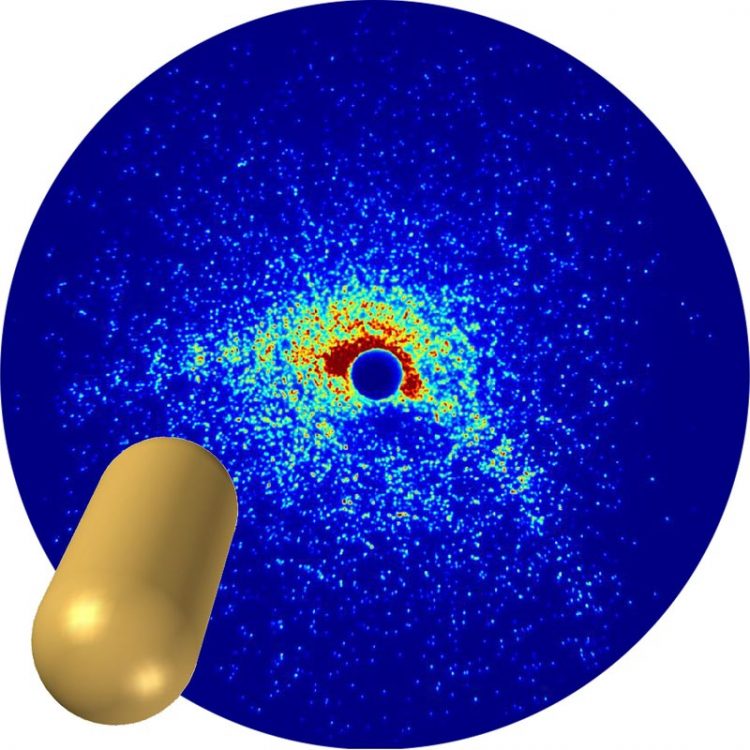First imaging of free nanoparticles in lab experiment using high-intensity laser source

Pill-shaped helium nanodroplets can be detected through curved structures in the scatter image. © MBI
In a joint research project, scientists from the Max Born Institute for Nonlinear Optics and Short Pulse Spectroscopy (MBI), the Technische Universität Berlin and the University of Rostock have managed for the first time to image free nanoparticles in a laboratory experiment using a high-intensity laser source.
Previously, the structural analysis of these extremely small objects via single-shot diffraction was only possible at large-scale research facilities using so-called XUV and x-ray free electron lasers. Their pathbreaking results facilitate the highly-efficient characterisation of the chemical, optical and structural properties of individual nanoparticles and have just been published in “Nature Communications”.
The lead author of the publication is junior researcher Dr Daniela Rupp who carried out the project at TU Berlin and is now starting a junior research group at MBI.
In their experiment, the researchers expanded helium gas through a nozzle that is cooled to extremely low temperature. The helium gas turns into a superfluid state and forms a beam of freely flying miniscule nanodroplets. “We sent ultra-short XUV pulses onto these tiny droplets and captured snapshots of these objects by recording the scattered laser light on a large-area detector to reconstruct the droplet shape,” explains Dr Daniela Rupp.
“Key to the successful experiment were the high-intensity XUV pulses generated in MBI’s laser lab that produce detailed scattering patterns with just one single shot,” explains Dr Arnaud Rouzée from MBI. “By using the so-called wide-angle mode that provides access to the three-dimensional morphology, we could identify hitherto unobserved shapes of the superfluid droplets,” adds Professor Thomas Fennel from MBI and the University of Rostock.
The research team’s results enable a new class of metrology for analysing the structure and optical properties of small particles. Thanks to state-of-the-art laser light sources, making images of the tiniest pieces of matter is no longer exclusive to the large-scale research facilities.
Physicist Dr Daniela Rupp worked as a scientist at the Institute of Optics and Atomic Physics at TU Berlin till summer 2017. Now she is launching a Leibniz Junior Research Group at MBI where she continues her research on single particle imaging with short and intensive extreme ultraviolet light pulses. Her work has been previously awarded by the DPG’s Dissertation Prize (AMOP Section), the Carl Ramsauer Prize of the Berlin Physical Society and the Physics Graduation Prize of the Wilhelm and Else Heraeus Foundation.
Publication:
Coherent diffractive imaging of single helium nanodroplets with a high harmonic generation source
Daniela Rupp, Nils Monserud, Bruno Langbehn, Mario Sauppe, Julian Zimmermann, Yevheniy Ovcharenko, Thomas Möller, Fabio Frassetto, Luca Poletto, Andrea Trabattoni, Francesca Calegari, Mauro Nisoli, Katharina Sander, Christian Peltz, Marc J. J. Vrakking, Thomas Fennel & Arnaud Rouzée. Nature Communications 8 (2017).
https://www.nature.com/articles/s41467-017-00287-z
Image downloads:
For further information please contact:
Dr Daniela Rupp
Max Born Institute for Non-Linear Optics and Short Pulse Spectroscopy (MBI)
E-mail: daniela.rupp@mbi-berlin.de
Phone +49 (0)30 6392-1280
https://www.nature.com/articles/s41467-017-00287-z
http://www.tu-berlin.de/?188814
Media Contact
All latest news from the category: Physics and Astronomy
This area deals with the fundamental laws and building blocks of nature and how they interact, the properties and the behavior of matter, and research into space and time and their structures.
innovations-report provides in-depth reports and articles on subjects such as astrophysics, laser technologies, nuclear, quantum, particle and solid-state physics, nanotechnologies, planetary research and findings (Mars, Venus) and developments related to the Hubble Telescope.
Newest articles

NASA: Mystery of life’s handedness deepens
The mystery of why life uses molecules with specific orientations has deepened with a NASA-funded discovery that RNA — a key molecule thought to have potentially held the instructions for…

What are the effects of historic lithium mining on water quality?
Study reveals low levels of common contaminants but high levels of other elements in waters associated with an abandoned lithium mine. Lithium ore and mining waste from a historic lithium…

Quantum-inspired design boosts efficiency of heat-to-electricity conversion
Rice engineers take unconventional route to improving thermophotovoltaic systems. Researchers at Rice University have found a new way to improve a key element of thermophotovoltaic (TPV) systems, which convert heat…



